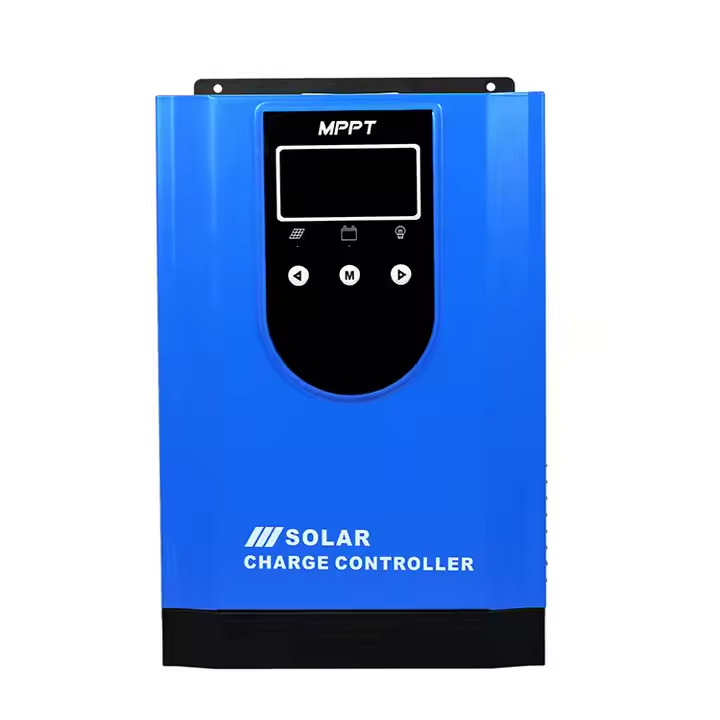I. Introduction
Solar charge controllers and hybrid inverters sit at the heart of any residential PV system, regulating power flow, maximizing energy harvest, and protecting batteries. In 2025, rapid technological advances—from AI‑driven Maximum Power Point Tracking (MPPT) algorithms to blockchain‑enabled grid services—are transforming these once‑static devices into intelligent, self‑optimizing components that deliver unprecedented efficiency and reliability
II. Next‑Gen Hardware Innovations
A. Advanced MPPT Algorithms
Modern controllers leverage adaptive, AI‑enhanced MPPT algorithms that identify and lock onto the true maximum power point in milliseconds, even under partial shading or rapidly changing irradiance . Research on neural‑fuzzy MPPT (ANFIS) reports up to 37% efficiency gains versus conventional methods in unstable light conditions .
B. Bifacial & High‑Voltage Compatibility
As bifacial panels capture reflected sunlight from both sides, next‑gen controllers now support the dual‑input voltages these modules produce—boosting yield by 5–15% without extra wiring complexity . Simultaneously, 1,500 VDC‑rated controllers reduce balance‑of‑system costs by enabling longer string runs and smaller conductors .
C. Compact, Hybridized Form Factors
Gone are the days of separate controller, inverter, and battery‑manager boxes. New plug‑and‑play modules combine MPPT control, DC‑to‑AC inversion, and battery management into a single unit, drastically simplifying installation and improving reliability
III. Smart Connectivity & Monitoring
A. IoT & Cloud Integration
Today’s controllers come with built‑in Wi‑Fi or cellular modems, streaming real‑time performance data to web or mobile dashboards. Users receive firmware updates over‑the‑air, ensuring continuous feature upgrades and security patches without site visits .
B. Edge AI & Predictive Maintenance
By analyzing on‑device data—voltages, currents, temperatures—controllers can now predict component wear or impending faults days in advance, automatically scheduling maintenance alerts and even reconfiguring MPPT parameters to avert failures.
C. Cybersecurity & Data Privacy
Secure controllers employ end‑to‑end encryption for all communications, and some pilot projects are using blockchain to create auditable, tamper‑proof energy‑trading records in community solar networks .
IV. Advanced Energy Management Features
A. Dynamic Load Shifting
Smart controllers now interface with home‑energy management systems (HEMS) to shift noncritical loads—EV charging, pool pumps—to high‑production windows, reducing grid draw and maximizing self‑consumption .
B. Vehicle‑to‑Grid (V2G) & Grid‑Forming Modes
Next‑gen hybrid inverters offer bidirectional power flow, using parked EV batteries as grid‑forming assets during outages or peak‑rate periods . Black‑start capabilities let them reboot local microgrids autonomously if the utility fails.
C. Multi‑Source Orchestration
Sophisticated controllers can now coordinate PV, wind turbines, and backup generators, automatically balancing inputs based on real‑time pricing, emission profiles, and system health .
V. Integration into the Home & Beyond
A. Smart‑Home Ecosystem Compatibility
Voice‑control integrations (Alexa, Google Home) let homeowners query solar output or even adjust charge‑discharge setpoints by voice. Open APIs enable unified dashboards that consolidate lighting, HVAC, and solar analytics in one interface .
B. Community Solar & Virtual Net Metering
Emerging “shared‑controller” models allow multi‑tenant buildings to collectively manage rooftop arrays, with smart contracts automatically allocating credits and simplifying billing .
C. Commercial & Industrial Scale‑Up
At the utility scale, modular micro‑inverter clusters and SCADA‑compatible hybrid controllers deliver real‑time plant optimization and granular fault detection across megawatt‑scale arrays .
VI. What’s Next? Future Directions
Solid‑State Power Electronics: Eliminating moving parts in inverters to boost reliability and efficiency to >99% .
Autonomous Microgrids with AI Orchestration: Neighborhood‑scale systems that self‑optimize and peer‑to‑peer trade energy.
Quantum‑Enhanced Forecasting: Ultra‑precise solar irradiance predictions to push MPPT responsiveness to new extremes.
Circular‑Design Controllers: Products engineered for disassembly and recycling, cutting end‑of‑life waste.
Conclusion & Call to Action
The cutting edge of solar charge controllers and hybrid inverters is moving faster than ever. By embracing these innovations—AI‑powered MPPT, bifacial compatibility, IoT security, and V2G readiness—you’ll unlock peak efficiency, resilience, and ROI for your home or project. Audit your existing system today, explore retrofit options, and work with a certified installer to upgrade to the latest generation of solar intelligence.



